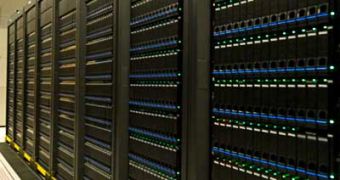Three key trends that will bring a new look on the datacenter industry have been predicted by a blade server group founded by IBM and Intel. The trends include network convergence with Ethernet technology, advanced energy efficiency techniques such as water cooling, as well as "hyper consolidation" involving both virtualization and blade servers.
A prediction about the disappearance of separate I/O lanes for data networking, storage traffic and intercrosses communications was made at a technology symposium hosted by Balde.org in New York on Thursday. According to Blade.org, network convergence will end the need to have adapters, connectors and wires for each lane.
"In the future, datacenters will converge I/O on Ethernet, running all their traffic on a single 'lane' or wire," Blade.org says. "This convergence is ideal for blade environments because they are tightly packed together with little room for extra components."
The transition will have as key components 10 Gigabit Ethernet and 40 Gigabit Ethernet, yet there are still some technology enhancements that are expected to arrive, says Doug Balog, chairman of Blade.org and vice president of development for IBM's blade and modular systems group. According to him, "10 Gigabit kind of becomes the foundation, but there are enhancements to Ethernet that are needed and coming forward as standards through IEEE, that will provide lossless capability through the 10 Gigabit fabric."
The list of "mega trends" was issued by the Blade.org board of directors with the purpose of giving an insight over the industry, as well as to urge discussions over the technology meant to change the datacenter industry during the following years.
The focus on energy efficiency is an expected inclusion on the trend list, given the lately developments in the industry regarding lowering power and cooling costs. Balog says that blade servers may prove to be both a solution and a problem in the future, as some customers were taken by surprise by the challenge of improving efficiency during the past few years.
"Blade servers are part of the solution because they are much more energy efficient than a rack full of 1U servers," he says. "But at the same time, because of the ability to provide a high-density offering within a smaller area, they're consuming more energy in a smaller space."
The fact that blade servers occupy less space than before makes data center managers tend to fill up the remaining space with other servers. "Blades are becoming part of the answer to a customer's data center challenges, but it has to be done in a thoughtful way so they're not creating their next set of problems," Balog says.
Blade.org predicts that about 70% of datacenters will use water to cool down their servers within the next three years, especially given the enhancements IBM has brought to water cooling lately. But, in order to solve the energy predicament in which datacenters currently are, various approaches will be necessary. "This [problem] is one that cannot be ignored," Balog says. "I think water cooling provides part of the answer. I wouldn't say we're looking at it as the only answer."
The last major trend is hyper consolidation, conducted by server virtualization and a predicted move toward "consolidating servers, workstations and network devices into an integrated blade environment."
There is a tendency for blades and virtualization to complement each other as they become more popular, says Blade.org. "Blades in the datacenter will evolve to a hyper-consolidated model through virtual appliances in which all discrete servers, firewalls and other network devices will be consolidated into the blade chassis," stated VMWare chief platform architect Richard Brunner in a press release.
Blade.org was founded in 2006 by IBM and Intel, and, during this time, it gathered around 200 members, including APC, Brocade, NetApp, VMware, QLogic, Citrix, HBC, and Wyse Technology. It seems that there are also some other large industry players on that list, such as HP (a strong competitor for Dell) or AMD (quite a match for Intel over some market areas) although they're kept silent.

 14 DAY TRIAL //
14 DAY TRIAL //